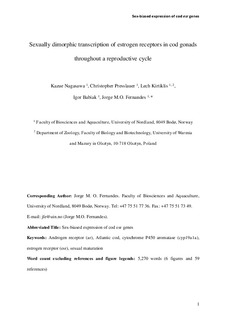Sexually dimorphic transcription of estrogen receptors in cod gonads throughout a reproductive cycle
Journal article, Peer reviewed
Permanent lenke
http://hdl.handle.net/11250/279299Utgivelsesdato
2014Metadata
Vis full innførselSamlinger
Originalversjon
Nagasawa, K., Presslauer, C., Kirtiklis, L., Babiak, I. & Fernandes, J.M.O. (2014). Sexually dimorphic transcription of estrogen receptors in cod gonads throughout a reproductive cycle. Journal of Molecular Endocrinology , 52(3), 357-371. doi: 10.1530/JME-13-0187Sammendrag
The role of sex steroid regulation in gonadal maturation is a very complex process that is far from being fully understood. Hence, we have investigated seasonal changes in gonadal expression of estrogen receptors (ERs) in Atlantic cod (Gadus morhua L.), a batch spawner, throughout annual reproductive cycle. Three nuclear ER partial cDNA sequences (esr1, esr2a and esr2b) were cloned and all esr transcripts were detected mainly in liver and gonads of either sex. In situ hybridization of esrs along with germ cell (vasa) and gonadal somatic cell markers (gsdf, 3β-hsd and amh for testicular, or gsdf for ovarian somatic cells) showed that in testis all three esrs were preferentially localized within interstitial fibroblasts composed of immature and mature Leydig cells, whereas in ovary they were differentially expressed in both follicular cells and oocytes. Quantitative real-time PCR analysis revealed a sexually dimorphic expression pattern of the three esr paralogues in testis and ovary. A significant increase in esr2a expression was identified in testis and esr2b in ovary, whereas esr1 transcripts were elevated in both testis and ovary at February and March prior to the spawning period. The localization and sexually dimorphic expression of esr genes in gonads suggest a direct function of estrogen via ERs in gonadal somatic cell growth and differentiation for Leydig cell in testis and follicular cells in ovary throughout the annual reproductive cycle in Atlantic cod.
